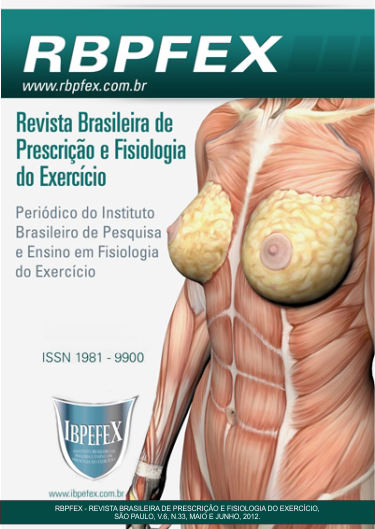Effect of heat stress on the state state of hydration of young people during practice volleyball
Abstract
The objective of this study was to evaluate the effect of the thermal stress on thehydration over a volleyball class. Participants were 18 students of Physical Education (9 males and 9 females), with age of 22,61±1,46 years, height 164,7±7,65cm, body weight 64,41±12,02kg. The fluid intake was "ad libitum" and the urine was collected before and after the class. The height and weight and, the evaluation of the dehydration through the density of the urine (Du) were measured by a digital stadiometer (WISO, W721), and refractometer, (Instrutherm, RTP-20ATC), respectively. The environmental conditions were registered by a digital thermo-hygrometer (Instrutherm, HT-260). The temperature and the relative humidity of the air were, respectively, 35,46±1,21 °C and 45,86±2,79%. The statistical analysis were based on t student test(p≤ 0,01). The water ingestion was 473,14±279,30 ml/h and the corporal weight at the end of the class was 63,77±12,07 Kg, the Du before and Du after were, respectively, 1022,56±8,02 and 1027,44±7,41SG. There was significant difference for Du. The amount of water ingested probably was not enough to hydro homeostasis. It is possible that the mechanism of the thirst was not efficient to maintain the water normality and that the allied exercise to the stress thermal increased the dehydration.
References
-American College of Sports Medicine (ACSM). Position Stand: Exercise and fluid replacement. Med. Sci. SportsExerc. Vol. 39. Núm. 2. p. 377-90. 2007.
-Armstrong, LE. Performance in extreme environments. Champaign: Human Kinetics, 2000.
-Arngrísson, S.A.; Stewart, D.J.; Borrani, F.; Skinner, K.A.; Cureton, K.J. Relation of heart rate to percent VO2 peak during submaximal exercise in the heat. J.Appl.Physiol.Vol.94, p.1162-1168. 2003.
-Braz, J. R. C. Fisiologia da termorregulação normal. Neurociências, São Paulo, p. 12-17, 2005.
-Brito, C. J.; Fabrini, S. P.; Marins, J. C. B. Mensuração de reposição hídrica durante o treinamento de judô. Revista Mineira de Educação Física, Viçosa, Vol. 15, Núm. 02, p. 144-152, 2007.
-Carvalho, T.; Mara, L. S. Hidratação e nutrição no esporte. Revista Brasileira de Medicina do Esporte, p. 144-148, 2010.
-Casa, D. J.; e colaboradores. National Athletic Trainer’s Association Position Statement (NATA): Fluid replacement for athletes. J Athl Train. Vol. 35. Núm. 2. p. 212-24. 2000.
-Fabrini, S. P.; e colaboradores. Práticas de redução de massa corporal em judocas nos períodos pré-competitivos. Revista brasileira de Educação Física e Esporte. São Paulo, Vol. 24, Núm. 2, p. 165-77, 2010.
-Ferreira, F. G.; e colaboradores. Efeito do nível de condicionamento físico e da hidratação oral sobre a homeostase hídrica em exercício aeróbico. Revista Brasileira de Medicina do Esporte, Núm. 3, p. 166-170, 2010.
-Guyton, A. C.; Hall, J. E. Tratado de Fisiologia Médica. 12ª edição. Rio de Janeiro. Elsevier. 2011.
-James, P.; e colaboradores. The Worldwide Obesity Epidemic.Obesity research. Vol. 9 Suppl. 4 November 2001.
-Lancha, A. H.; Ferraz, P. L. C.; Rogeri, P. S. Suplementação nutricional no esporte. Rio De Janeiro: Guanabara Koogan, 2009.
-Mcardle, W. D.; Katch, F. I.; Katch, L. V. Fisiologia do Exercício: Energia, Nutrição e Desempenho Humano. Rio de Janeiro. Guanabara Koogan, 2011.
-Moreira, C. A. M. e colaboradores. Hidratação durante o exercício: a sede é suficiente? Revista Brasileira de Medicina do Esporte, São Paulo, Vol. 12, Núm. 6, p. 405-409, 2006.
-Murray, B. Hydration and physical performance. J. Am. Coll. Nutr. Vol. 26. p. 542-8. 2007.
-Oliveira, E. A. M.; Anjos, L. A. Medidas antropométricas segundo aptidão cardiorespiratóia em militares da ativa, Brasil. Revista Saúde Pública, p. 217-223, 2008.
-Pitts, G. C.; Johnson, R. E.; Consolazio, F. C. Work in the heat is affected by intake of water salt and glucose. Am J Physiol. Vol. 142. p. 253-9. 1994.
-Sawka, M. N.; Noakes, T. D. Does dehydration impair exercise performance? Med. Sci. Sports Exerc. Vol. 39. Núm. 8. p. 1209-17. 2007.
-Tourinho Filho, H.; Tourinho, L. S. P. R. Crianças, adolescentes e atividade física: aspectos maturacionais e funcionais. Rev. Paul. Educ. Fís. São Paulo, Vol. 12. Núm.1. p. 71-84, 1998.
Authors who publish in this journal agree to the following terms:
- Authors retain the copyright and grant the journal the right of first publication, with work simultaneously licensed under the Creative Commons Attribution License BY-NC which allows the sharing of the work with acknowledgment of the authorship of the work and initial publication in this journal.
- Authors are authorized to enter into additional contracts separately for non-exclusive distribution of the version of the work published in this journal (eg, publishing in institutional repository or book chapter), with acknowledgment of authorship and initial publication in this journal.
- Authors are allowed and encouraged to post and distribute their work online (eg, in institutional repositories or on their personal page) at any point before or during the editorial process, as this can bring about productive change as well as increase impact and impact. citation of published work (See The Effect of Free Access).






